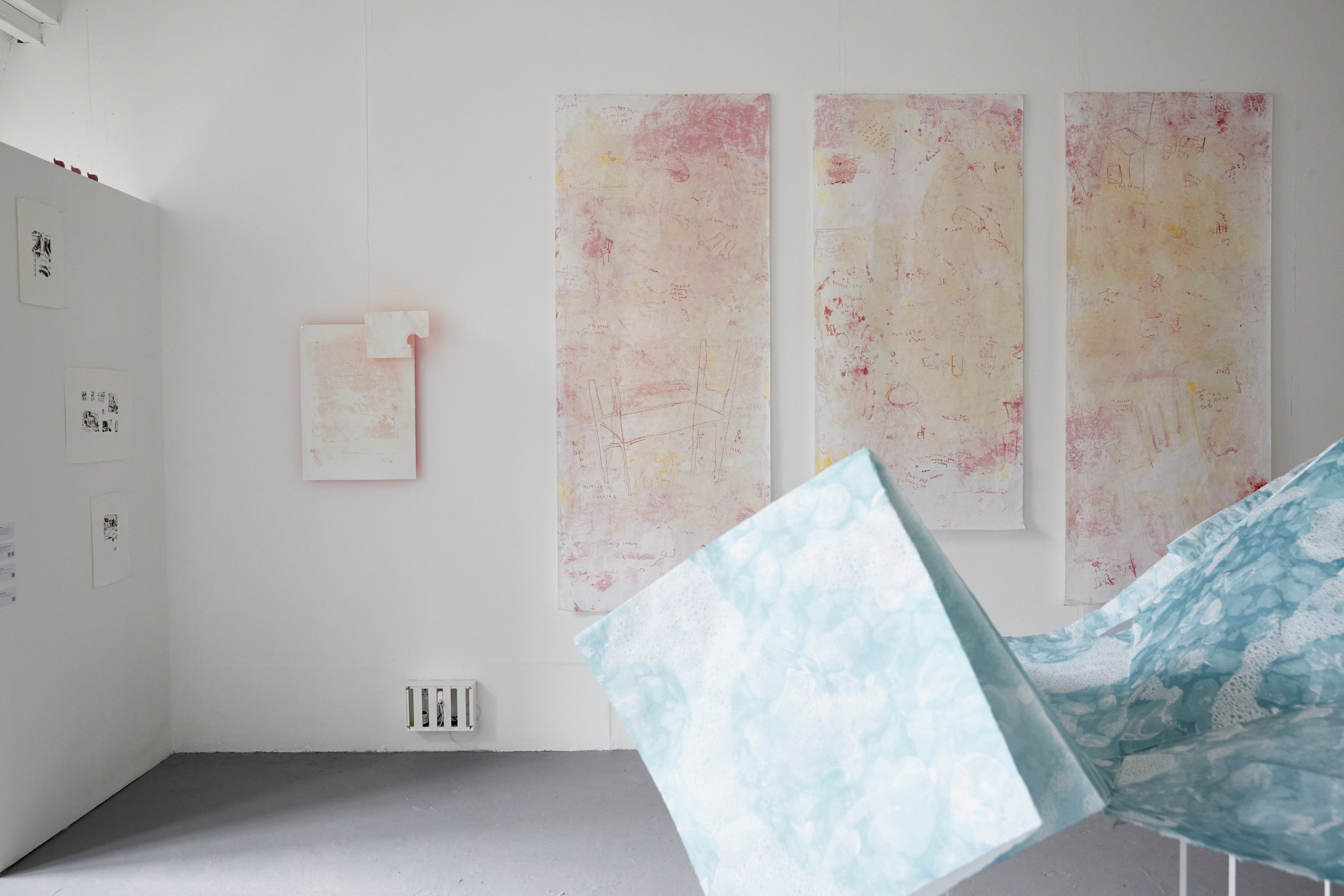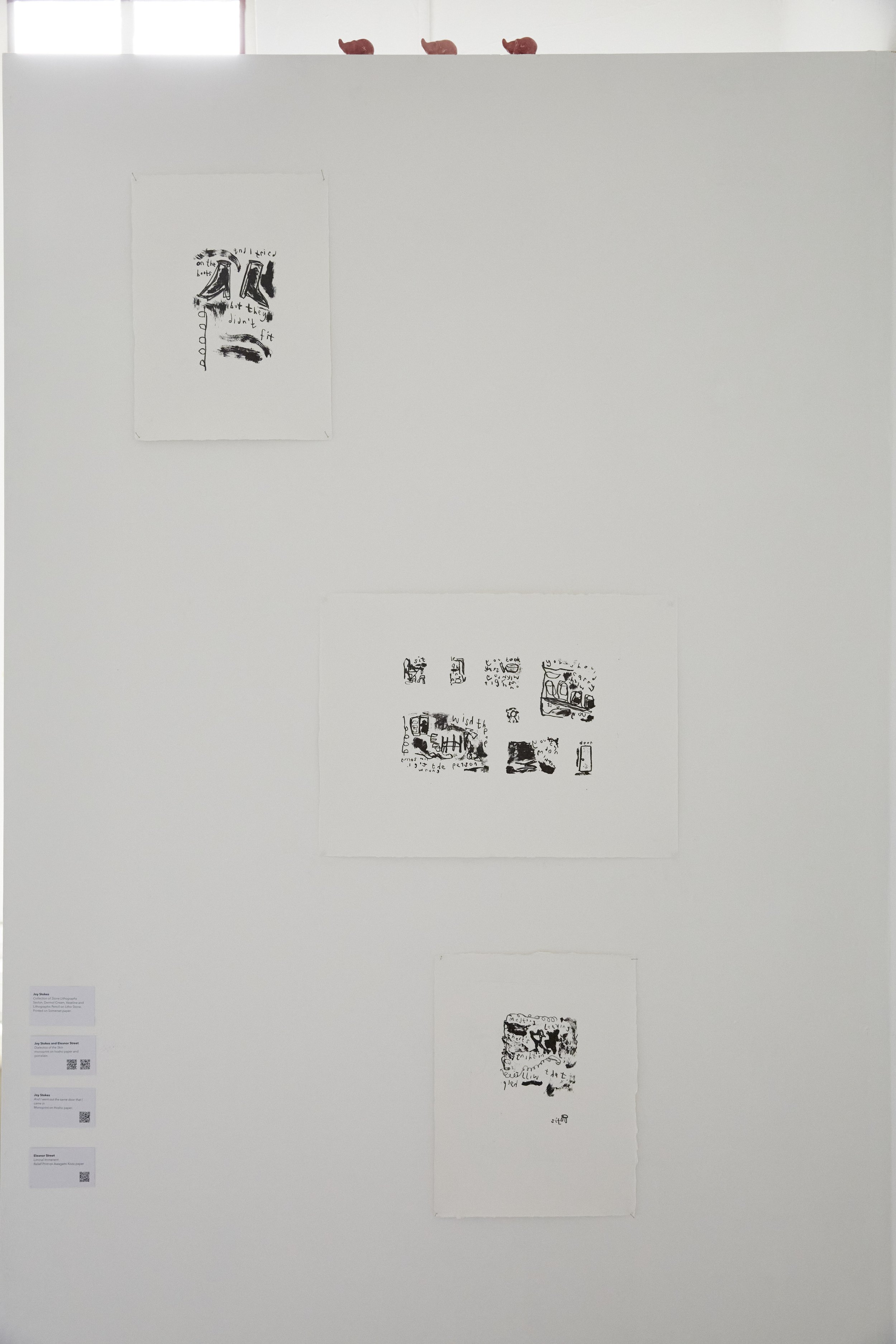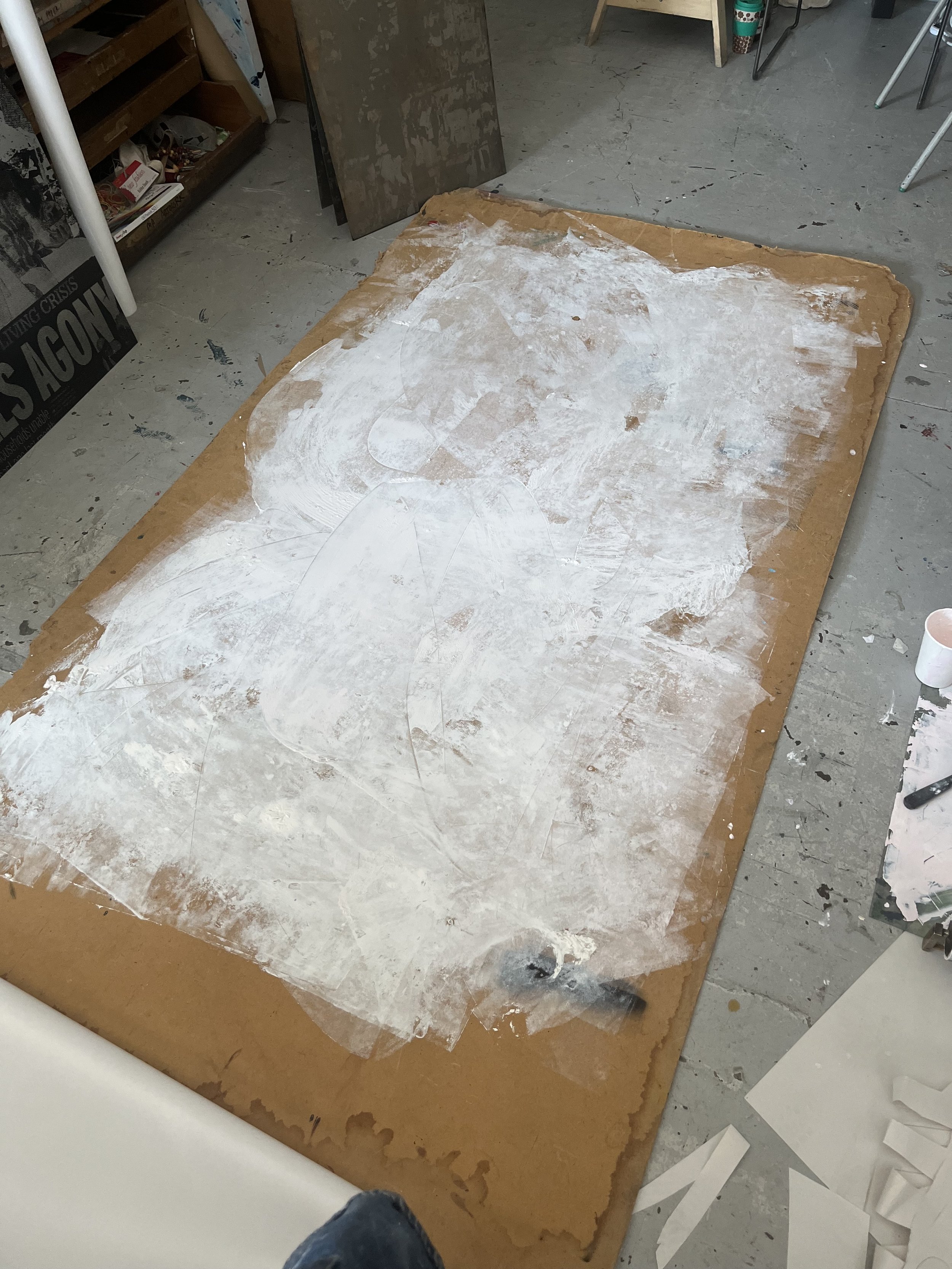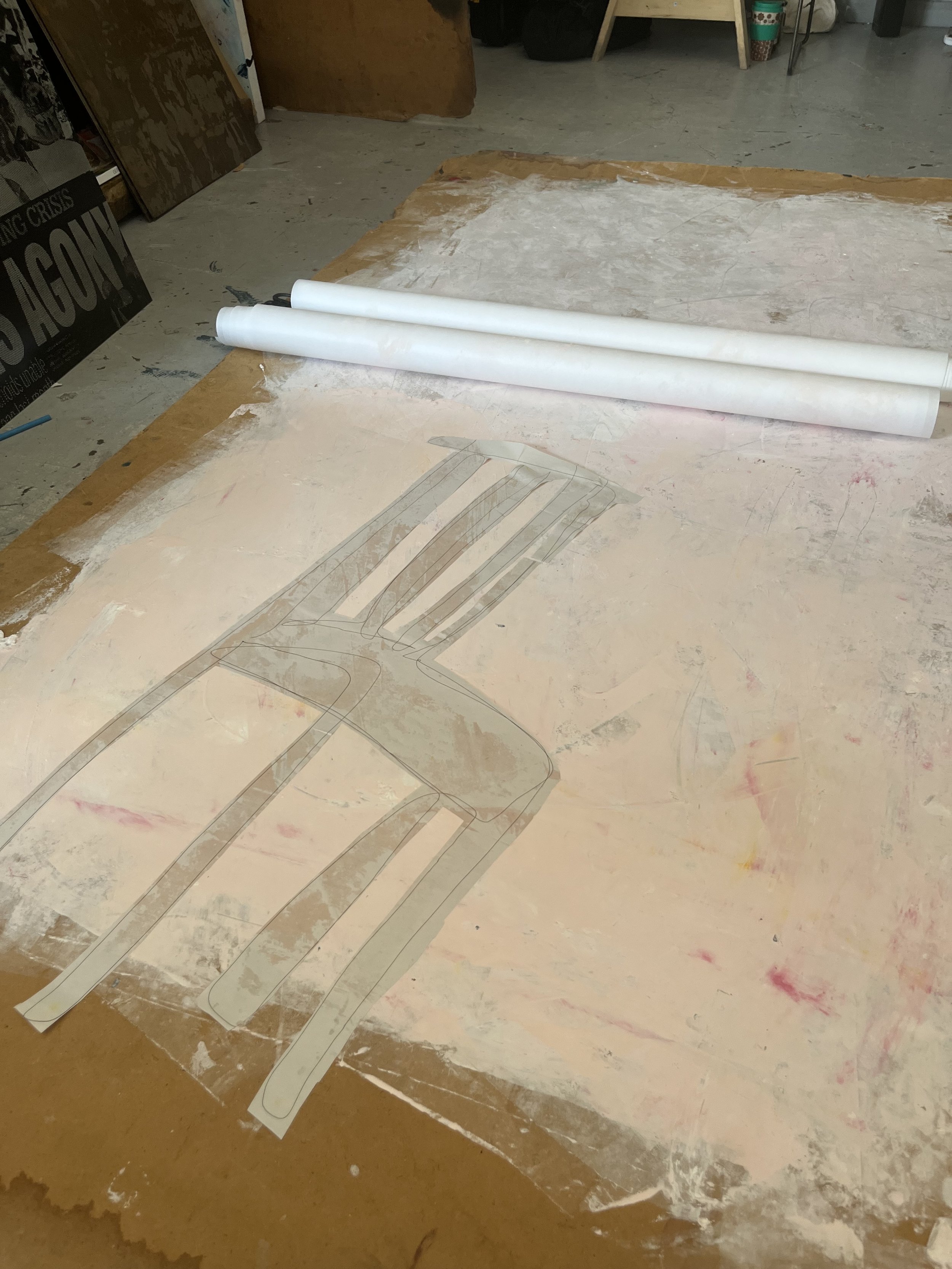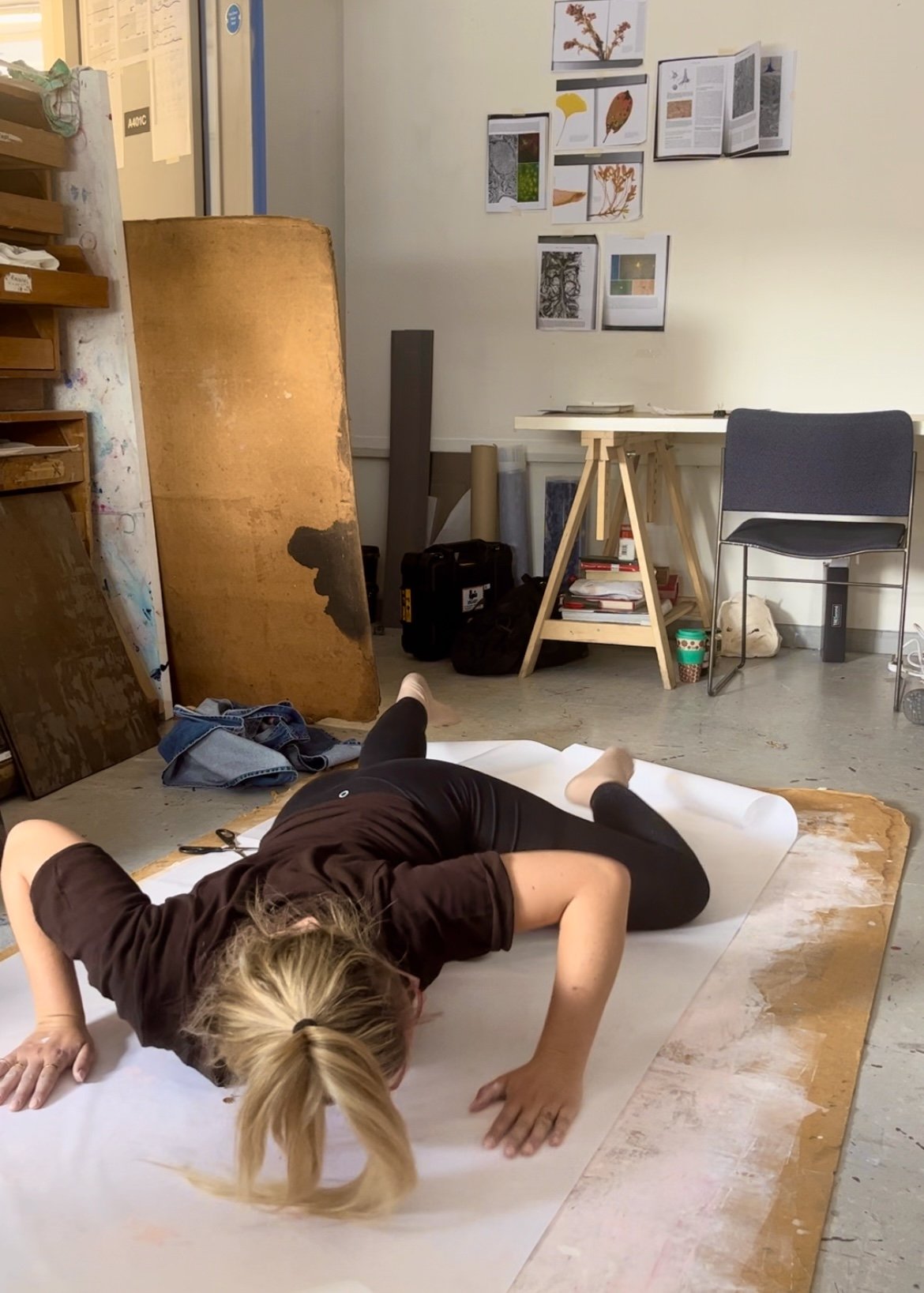Unit 3: Documentation
Postgraduate SHOW 2023
Documentation of our Unit 3 MA Exhibition in July
For the Postgraduate SHOW 2023, I presented a small body of resolved works centred around my key themes: the body, physicality and traces.
The most significant development in my practice since starting the Postgraduate course was my progression away from beginning my making process with the intention of creating a resolved image. This has allowed for greater experimentation within my practice and has enabled me to develop a more thorough understanding of my key themes and where I wish to position my work.
Having reflected upon the Unit 2 exhibition at Bargehouse, Oxo Tower Wharf, I was able to understand the ramifications of exhibiting as part of a group show and how I would adapt for the Postgraduate SHOW in July. My pieces at Bargehouse struggled to compete with the infrastructure of the space and the surrounding work of my peers. This was partly due to presentation and a lack of clarity within my ideas.
The formulation of my work has developed as I continued to explore different methods of mark making and creating my imagery, whether gestural and expressive or delicate. I consider mark making to be a visual representation of movement which means the resulting image can be considered as a tangible form of energy. This is a notion that I began to explore at the start of Unit 3 and it formed the basis of my exploration into making mono prints using my body as a tool for expression.
Exploring bodily traces in creating imagery led to my creation of And I went out the same door that I came in, three large monoprints where the basis of the image was created by inking up a large piece of wood onto which I laid a large sheet of Hosho paper, importantly big enough to cover the length of my body lying down. I then lay on top of the paper, creating the marks on the paper from the pressure of my body. I repeated this with each new layer of colour. I then worked into the image in smaller sections by monoprinting with a pencil and a needle to write and draw.
Alongside this piece, I wanted to exhibit a series of stone lithographs that I had made where the greasy marks on the stone that created the resulting print were made up of medical creams and gels. These products are available to me on prescription as part of the ongoing treatment of the chronic health condition that I have.
Eleanor Street and I had been testing combinations of our works to form on collaborative piece. This resulted in Dialectics of the Skin. This felt like a significant progression in both of our practices and in the possibilities of our future collaborations.
In conclusion, I decided to present a cohesive collection of resolved works that showcased my three main processes; monoprint, lithography and collaboration in relation to my three key themes; the body, physicality and traces. Below are images of the works exhibited.
And I went out the same door that I came in
MEDIUM: Monoprint on Hosho paper
DIMENSIONS: Left to right: 90x175cm, 90x150cm, 90x170cm
ABOUT: This work explores ideas of physicality and traces of movement made by the body. Within the piece are references to superstitions and retelling of stories. The objects that can been seen within the work, the chair and the bed gesture to the furniture that holds our bodies and the implications of the human form that can be seen through them. The door is symbolic of the boundary between internal and external.
Presentation was important and I wanted them to be lifted to play upon the idea of weight and weightlessness. Attached to wooden batons they floated off the wall and fluttered slightly when walked past or when caught by the breeze from the open windows. Playing from below the pieces was a sound piece made from the recording of my Pneumatic Compression pumps. Similar to a white noise and playing on a loop, it was there to hint towards the constant hum of life, and the continual maintenance of my health condition.
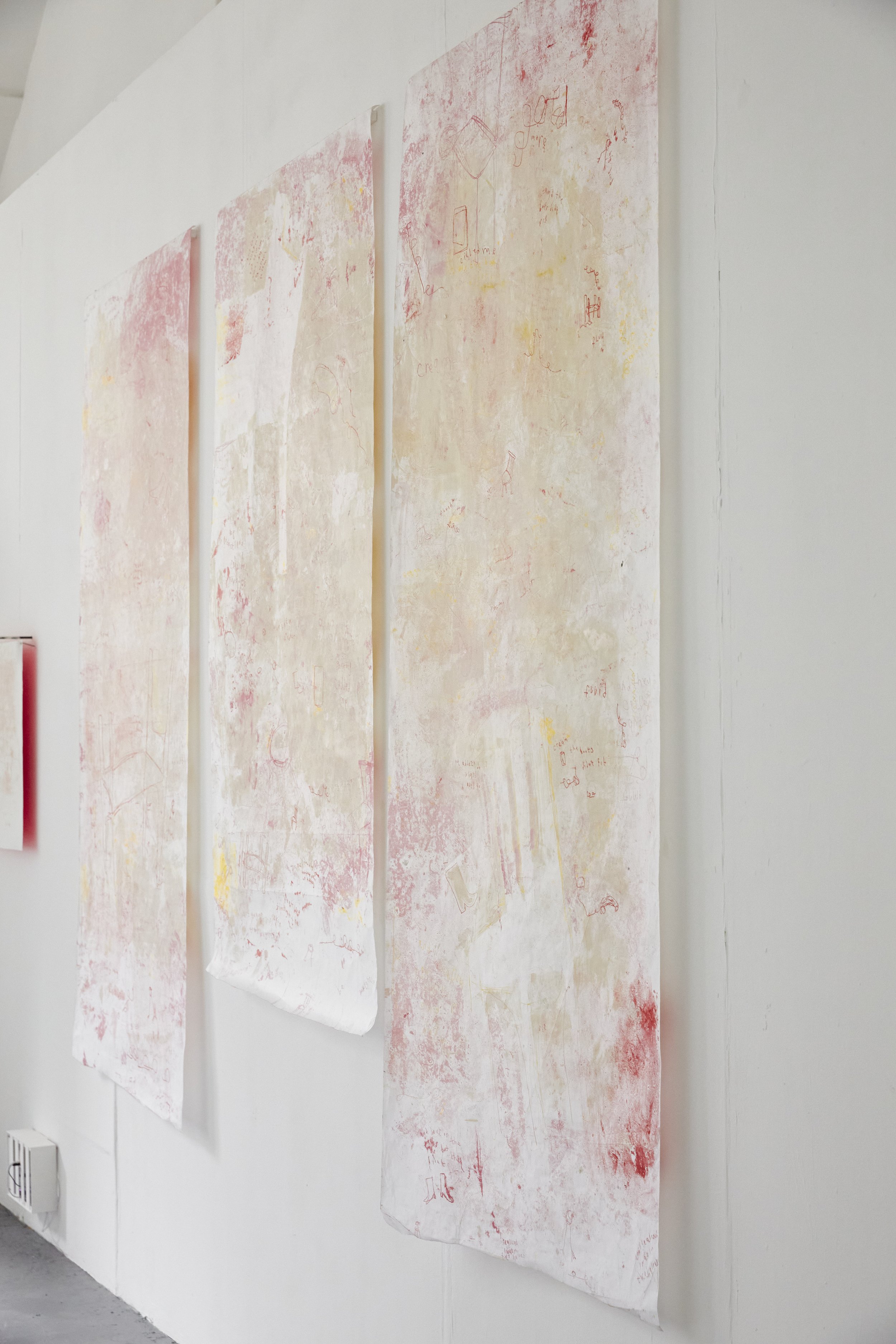

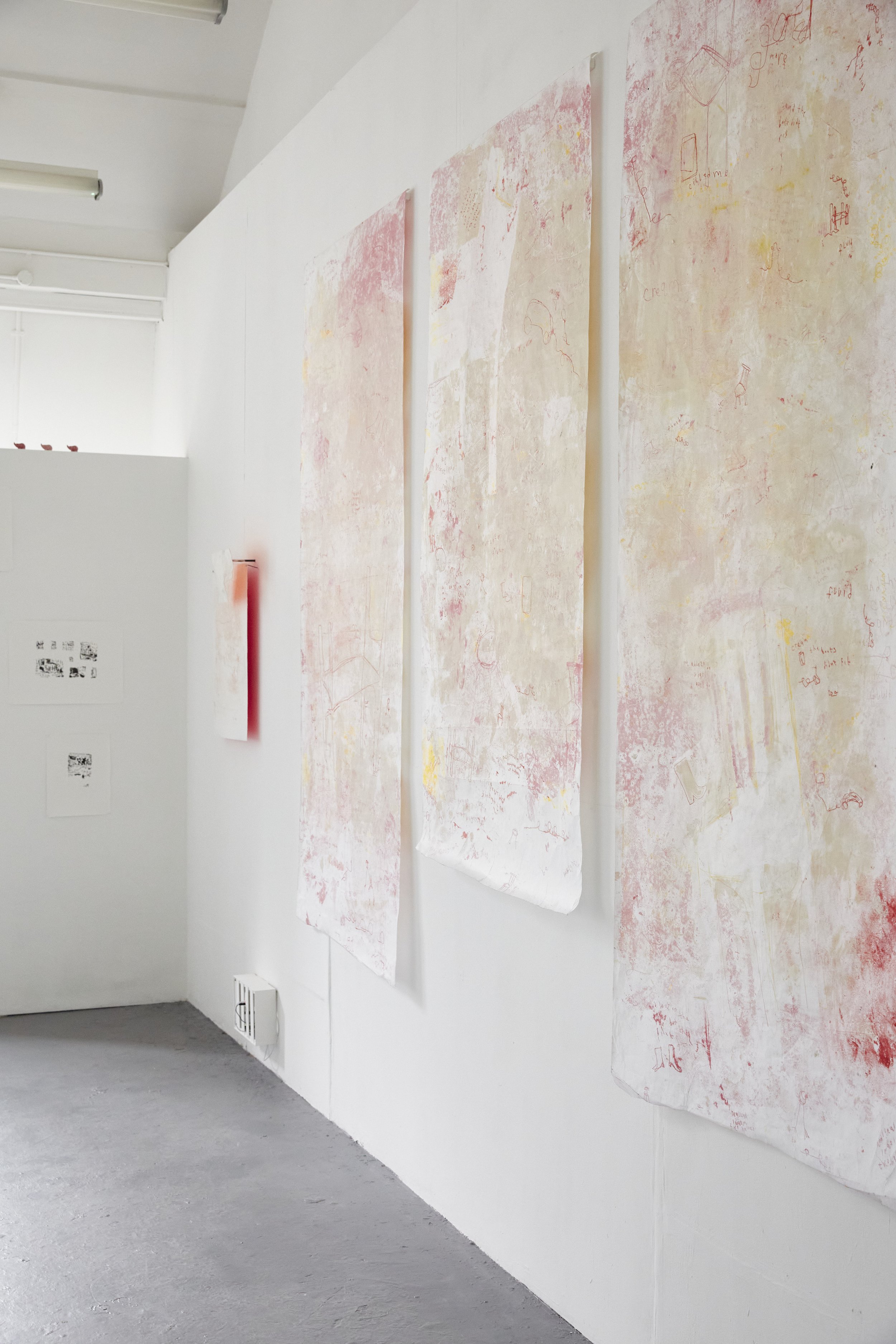

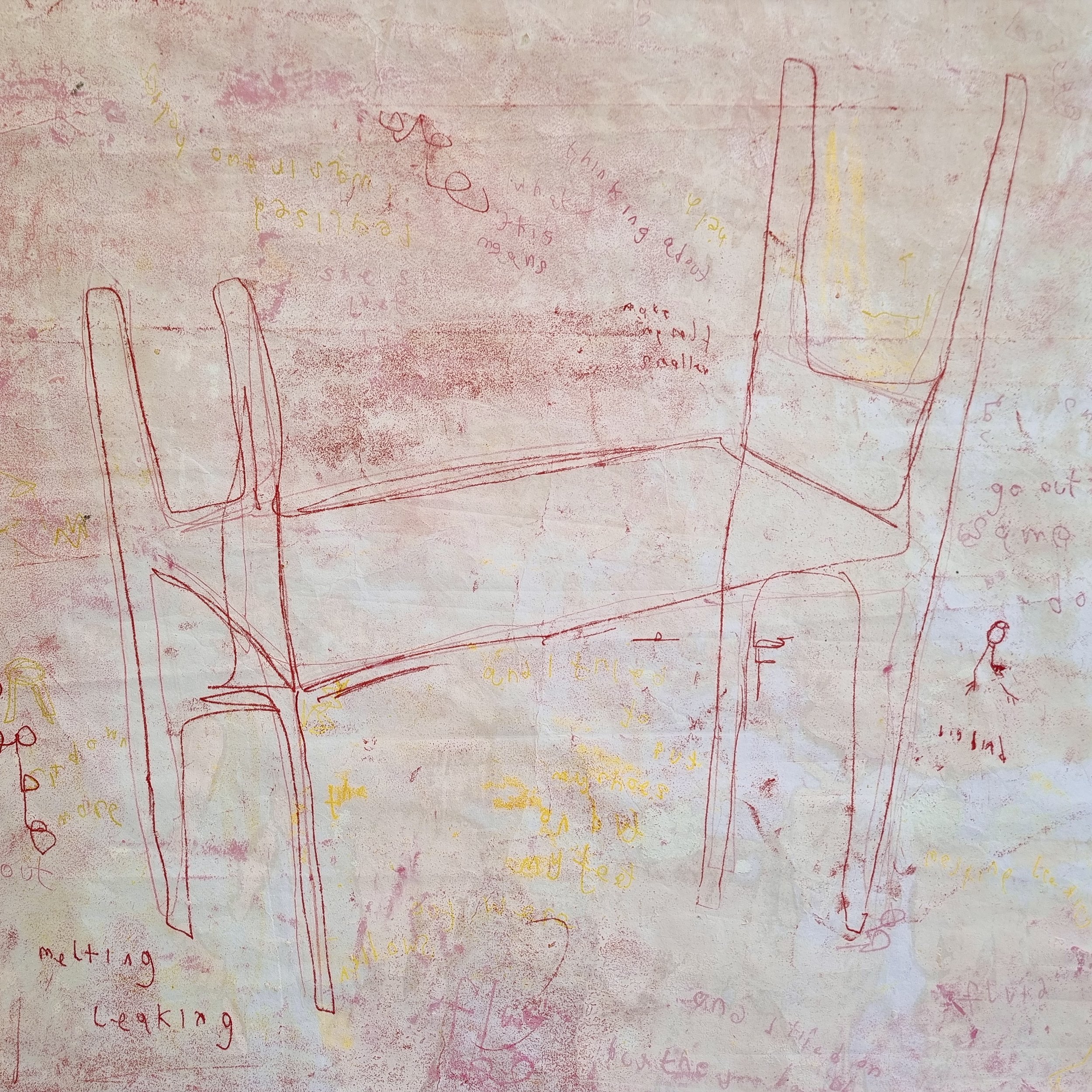
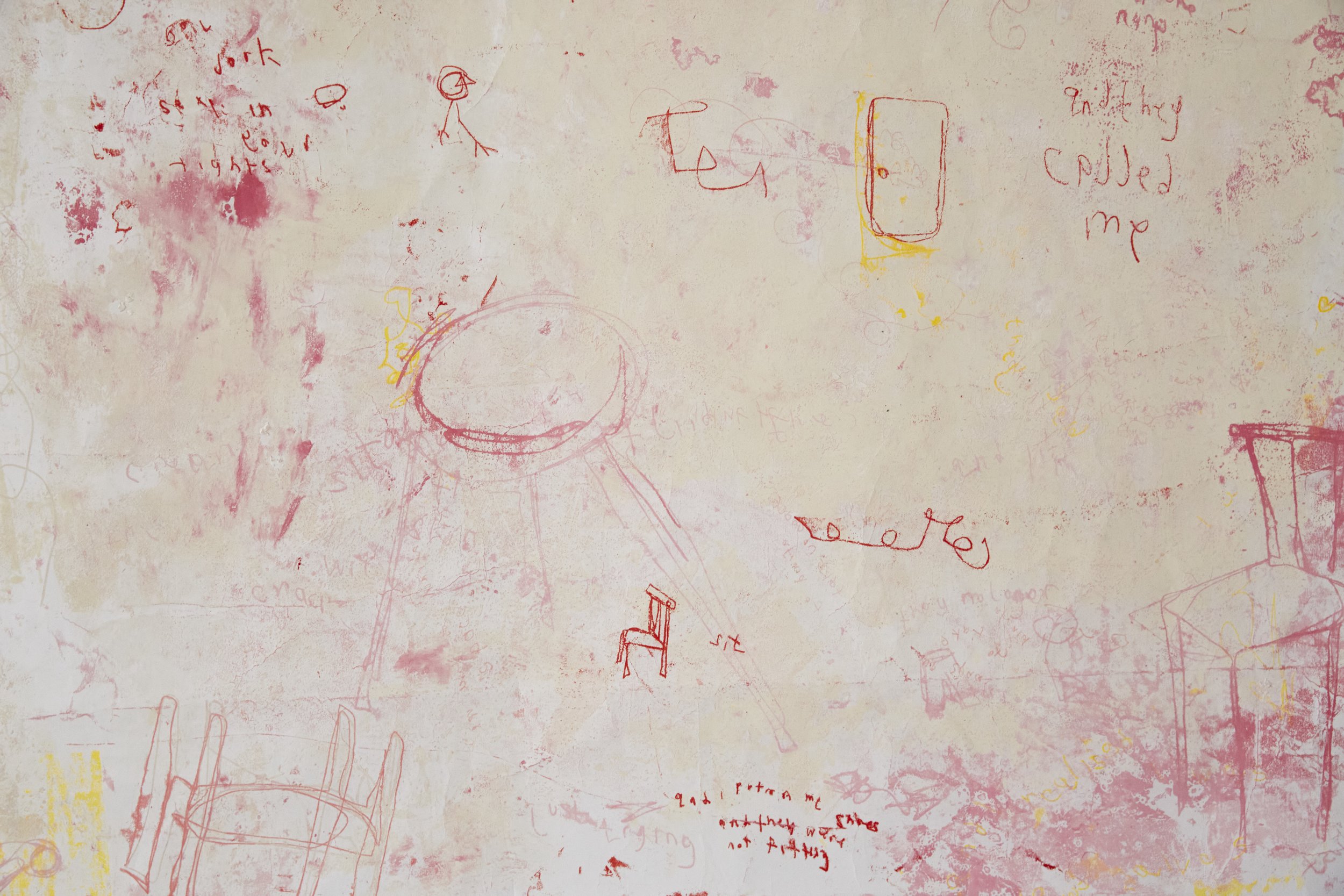

Dialectics of the Skin
Medium: monoprint on Zerkall paper with porcelain tile and acrylic paint.
Dimensions: 76x56x10cm
About: This work is a collaboration with Eleanor Street, it considers the paradox of the skin’s fragility namely in the context of Lymphoedema where the skin needs regular heavy moisturisation with thick, greasy creams to prevent cracking and tearing. It highlights the importance of the skin’s function as a barrier between the internal body and the outside world.
This conversation is had due to the delicate, almost translucent print being mirrored by the delicate but opaque porcelain piece. Both fine and fragile in nature are highlighted by a neon hum projected on the wall behind from the painted backs of the works.
Series of Stone Lithographs
Medium: Stone Lithograph on Somerset paper
Dimensions: Top to bottom, 44x34cm, 36x50cm, 44x34cm
About: This series of three stone lithograph prints were taken from a larger and ongoing series of Stone Lithograph prints that I have made where the image is a result of using different moisturising creams that I have on prescription.
In the end I chose these three to present as part of the body of work that I would present for the SHOW. Printed on heavy Somerset paper in black and rooted in their solid nature, they would sit in contrast to the monoprints on thin Japanese paper in bright and bodily colours.
Unit 3: Process
Methods & Materials
Reflections on significant developments in my practical work over the course of Unit 3.
The most significant development in my practical work has been the use of my body as a tool for mark making and expression. Consequently, my work has become more performative and explorative of creating more gestural imagery.
I have used depth of colour as a means of demonstrating intensity of movement. Softer, more bodily tones are representative of slower and more overall and encompassing movement. Deeper, vibrant and neon colours illustrate more controlled and definitive mark making and story telling.
Using my body as a tool for mark making has become the foundation for my work and during this Unit I have created some resolved pieces but also many which are open to being developed and tested further. This could be by pushing the materiality of the paper, by developing the imagery or by exploring further collaborations with Eleanor Street.
Process Videos & Images: Using my body as a tool for mark making
This first collection of documentation is using my body to create mark making through monoprint. All are made by the inking up of a surface, wood or perspex and laying a piece of paper on top.
ABOVE: Process video & images for And I went out the same door that I came in
ABOVE: Process video and video stills for Dancing series
Above: Process video and images of some resulting works
Medium: Monoprint on Zerkall paper
Zinc Lithograph experiments: First Tests
Medium: Zinc Lithograph prints on Zerkall, Hereford and Canaletto paper.
Dimensions: 54x76cm approx
About: This series of experiments was made using a large Zinc plate and by covering my skin in a greasy moisturiser and imprinting my feet and legs by placing them on the plate.
I tested using the plate over some already existing artworks such as over some of my own monoprints and over laser-etched woodcut print of Eleanor’s.
This was a useful experiment to test how effective marks can be made using my skin on the plate however, I didn’t like the obvious and static nature of the image.
Zinc Lithograph experiments: Second Tests
Medium: Zinc Lithographs on Canaletto paper.
Dimensions: 50x70cm
About: Using the same method as above, I used my legs to create the resulting marks on the plate. I liked how fluid the marks became and how evident they were of movement having taken place. I also liked how so much texture could be seen from my skin and how up close, the detail almost resembled something from nature or a landscape.
This was my second attempt at printing this zinc plate in this way as my previous plate had not worked. I had faced challenges in how quickly i was able to process the plate after making the marks which had caused the greasy marks to spread over the plate. This one I was able to process much quicker which meant that there was clear definition in the marks and difference between the areas that had marks and that didn’t.
I have printed this plate in colour and my next step is to experiment further printing in colour and on different paper. I also want to experiment with oiling up papers before and after printing so that they become translucent.
My classmate, Eleanor and I have also experimented with overprinting some of our works together and this plate is one that I would like us to test combining with some of her pieces.
Since learning that I will be the next Lithography Fellow, I have been pushing my Lithography skills and knowledge and learning a lot of new techniques. Through the guidance of technician Charlotte, I have leant new skills which are allowing me to develop my works, particularly in stone lithography.
